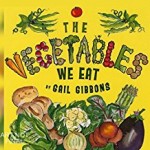G ail Gibbon’s book, The Vegetables We Eat, is both an introduction to the different kinds of vegetables and a mini botany lesson. Gibbons begins with the concepts of perennials and annuals and a definition of vegetable before going on to discuss different vegetable groups organized by the part of the plant that we eat: leaf, bulb, flower bud, root, tuber, stem, fruit, and seed. We learn that watercress and parsley are leafy vegetables like spinach and lettuce, that we eat the flower buds of cauliflower, artichokes and broccoli, and that tomatoes, cucumbers, and eggplant are actually fruits. While most vegetables are annuals asparagus and rhubarb are perennials. Special attention is given to soybean because of all the different products derived from it including tofu, oil, and soy sauce as well as cloth, paper, and paint.
ail Gibbon’s book, The Vegetables We Eat, is both an introduction to the different kinds of vegetables and a mini botany lesson. Gibbons begins with the concepts of perennials and annuals and a definition of vegetable before going on to discuss different vegetable groups organized by the part of the plant that we eat: leaf, bulb, flower bud, root, tuber, stem, fruit, and seed. We learn that watercress and parsley are leafy vegetables like spinach and lettuce, that we eat the flower buds of cauliflower, artichokes and broccoli, and that tomatoes, cucumbers, and eggplant are actually fruits. While most vegetables are annuals asparagus and rhubarb are perennials. Special attention is given to soybean because of all the different products derived from it including tofu, oil, and soy sauce as well as cloth, paper, and paint.
Gibbon then takes readers to the growing of vegetables showing us first how to make a home vegetable garden including one in the city. Next we learn about big commercial vegetable farms and how they use large machinery to plow, fertilize, harrow, plant, harvest, and haul to processing plants or local markets. No matter where you obtain your vegetable, implies Gibbons, vegetables are delicious! A concluding page gives us interesting facts about vegetables like potatoes originally came from South America, the longest bean is three feet long, and Benjamin Franklin introduced soybean seeds from France about 1800.
The text is clearly written with short sentences that get right to the point. The colorful lively pictures go well with the text and add to the excitement of exploring the world of vegetables. The Vegetables We Eat is a great resource for inspiring an interest in growing and eating vegetables.
To buy The Vegetables We Eat from Amazon.com Click Here.